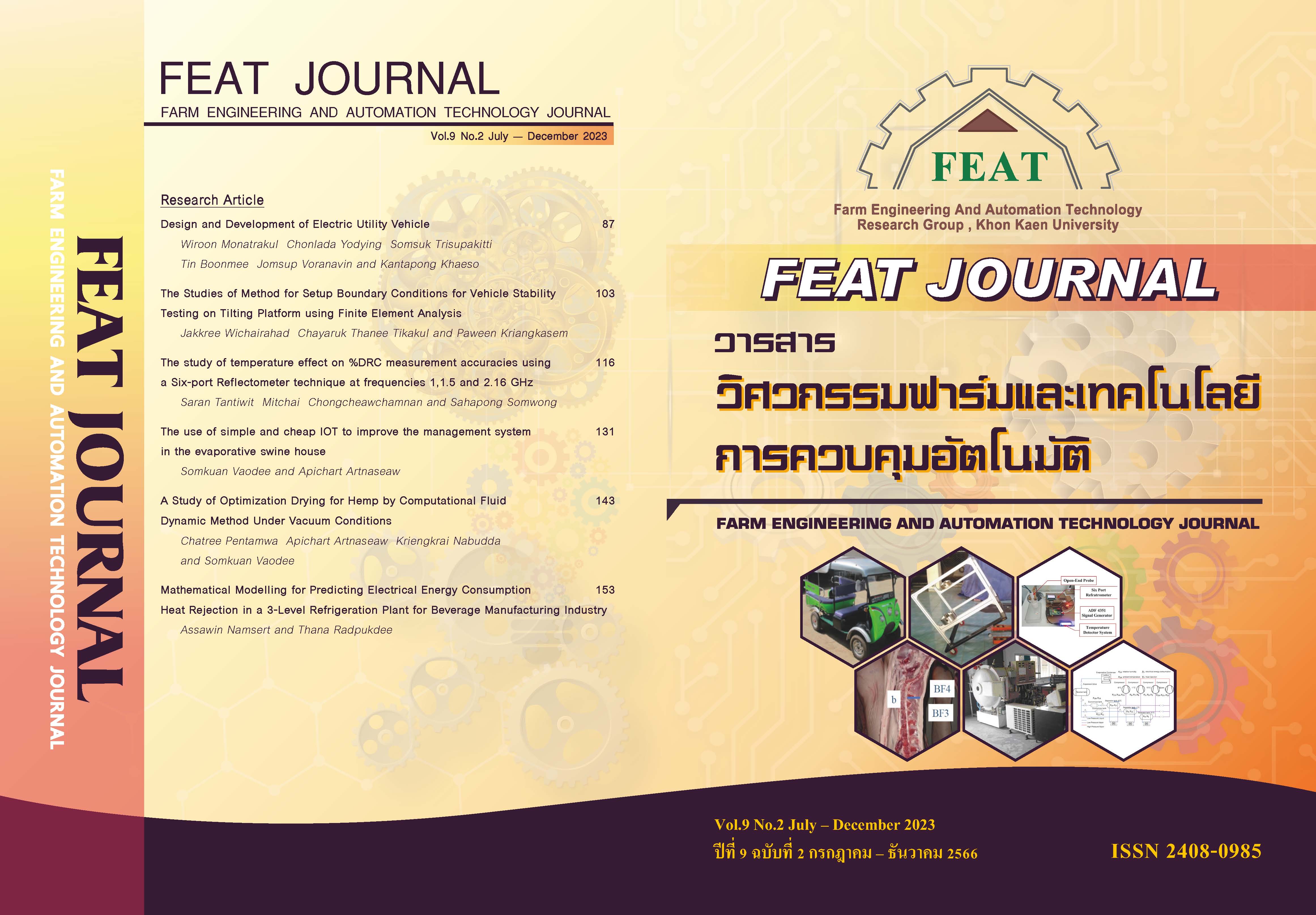การศึกษาความเหมาะสมของการอบแห้งสำหรับพืชกัญชง โดยวิธีการพลศาสตร์ของไหลเชิงคำนวณภายใต้สภาวะสุญญากาศ
Main Article Content
บทคัดย่อ
งานวิจัยนี้มีวัตถุประสงค์ในการศึกษาสภาวะการอบแห้งที่เหมาะสมของพืชกัญชงโดยใช้พลศาสตร์ของไหลเชิงคำนวณ ในเครื่องอบแห้งสุญญากาศ วัสดุและวิธีการของการวิจัยโดยนำวิธีการสุ่มไฮเปอร์คิวบ์แบบลาติน 20 คู่อันดับ มาใช้คำนวณหาค่าความดันในช่วง 10-30 kPa และอุณหภูมิ 40-60 °C จากนั้นนำไปใช้คำนวณหาเส้นทางการไหลของอากาศในห้องอบแห้งเพื่อดูการกระจายตัวของอุณหภูมิในแต่ละชั้นสำหรับพืชกัญชงโดยคุณสมบัติของพืชกัญชงที่ใช้คำนวณมีดังนี้ ความหนาแน่น 611 kg/m3 ค่าการนำความร้อน 140.8 W/m-K ผลลัพธ์ของความดันและอุณหภูมิที่มีการกระจายตัวของอุณหภูมิในแต่ละชั้นสำหรับพืชกัญชงอย่างสม่ำเสมอ คือ แบบจำลองที่ความดัน 12 kPa และมีอุณหภูมิ 57.4 °C บทสรุปของงานวิจัยนี้ของการใช้พลศาสตร์ของไหลเชิงคำนวณ (CFD) สามารถคำนวณการทำงานของระบบเครื่องอบแห้งสุญญากาศได้โดยที่พัดลมหมุนด้วยความเร็วรอบ 158 rpm และความเร็วที่ใช้การดูดอากาศของปั๊มสุญญากาศ 1.61 m/s
Article Details

อนุญาตภายใต้เงื่อนไข Creative Commons Attribution-NonCommercial-NoDerivatives 4.0 International License.
วารสารวิศวกรรมฟาร์มและเทคโนโลยีควบคุมอัตโนมัติ (FEAT Journal) มีกําหนดออกเป็นราย 6 เดือน คือ มกราคม - มิถุนายน และ กรกฎาคม - ธันวาคม ของทุกปี จัดพิมพ์โดยกลุ่มวิจัยวิศวกรรมฟาร์มและเทคโนโลยีควบคุมอัตโนมัติ คณะวิศวกรรมศาสตร์มหาวิทยาลัยขอนแก่น เพื่อเป็นการส่งเสริมและเผยแพร่ความรู้ ผลงานทางวิชาการ งานวิจัยทางด้านวิศวกรรมศาสตร์และเทคโนโลยีพร้อมทั้งยังจัดส่ง เผยแพร่ตามสถาบันการศึกษาต่างๆ ในประเทศด้วย บทความที่ตีพิมพ์ลงในวารสาร FEAT ทุกบทความนั้นจะต้องผ่านความเห็นชอบจากผู้ทรงคุณวุฒิในสาขาที่เกี่ยวข้องและสงวนสิทธิ์ ตาม พ.ร.บ. ลิขสิทธิ์ พ.ศ. 2535
เอกสารอ้างอิง
Disthai. Cannabis (Internet). [cited 2022 April 3]. Available from: https://www.disthai.com.
Machinery Intelligence Unit. Carrier oil extraction (Internet). [cited 2022 April 4]. Available from: https://miu.isit.or.th.
Chen C, Wongso I, Putnam D, Khir R and Pan Z. Effect of hot air and infrared drying on the retention of cannabidiol and terpenes in industrial hemp (Cannabis sativa L.). Industrial Crops and Products. 2021; 172: 114051.
Ratinun L, Sirithon S, Somnuk T and Apichart A. Heat and Moisture Transfer Equations for a Vacuum Drying. KKU Research Journal. 2016; 16(2): 1-14.
Sirithon S, Ratinun L, Somnuk T and Apichart A. Drying of Carrots by Using a Vacuum Heat Pump Dryer. KKU Research Journal. 2016; 16(3): 1-11.
Benfratello S, Capitano C, Peri G, Rizzo G, Scaccianoce G and Sorrentino G. Thermal and structural properties of a hemp–lime biocomposite. Construction and Building Materials. 2013; 48: 745-54.
Tanongsak Bootwong and Jaratsri Rungrattanaubol. Construction of the optimal Latin hypercube designs using the iterated local search algorithm. Thai Journal of Operational Research. 2013; 2: 1-11.
Huang S, Jiao J and Guedes Soares C. Uncertainty analyses on the CFD–FEA co-simulations of ship wave loads and whipping responses. Marine Structures. 2022; 82: 103129.
Ni L, Chen Z, Mukhopadhyaya P, Zhang X, Wu Q, Yu Q, et al. Numerical simulation on thermal performance of vacuum insulation panels with fiber /powder porous media based on CFD method. International Journal of Thermal Sciences. 2022; 172: 107320.
Turgut SS, Küçüköner E, Feyissa AH and Karacabey E. A novel drying system – simultaneous use of ohmic heating with convectional air drying: System design and detailed examination using CFD. Innovative Food Science & Emerging Technologies. 2021; 72: 102727.
Benfratello S, Capitano C, Peri G, Rizzo G, Scaccianoce G and Sorrentino G. Thermal and structural properties of a hemp–lime biocomposite. Construction and Building Materials. 2013; 48: 745-54.


